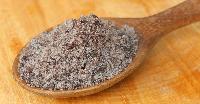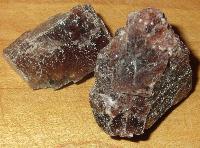
Get Price Quote
Black Salt - Fine Powder, Rock Salt, Soap Nuts, Yellow Mustard Seeds

Black Salt
Get Price Quote
100 Kilogram (MOQ)
Best Deals from Edible Salt

Black Salt
Get Price Quote
Kala Namak From Wikipedia, the free encyclopedia Jump to: navigation, search Whole Kala Namak salt crystals Kala Namak (Bengali Biit lobon (বিট লবণ); Newari Be Chi; Nepali Birae Nun (बिरे नुन) ; Hindi काला नमक ; Urdu کالا نمک kālā namak; Gujarati સંચળ Sanchal; Tamil இந்துப்பு) , also known as black salt or kala loon or black Indian salt, is a salty and pungent smelling condiment used in South Asia. The condiment is composed largely of sodium chloride with several impurities lending the salt its colour and smell. The smell is mainly due to sulfur content. Due to impurities in the mineral, it is brownish pink to dark violet translucent stone when whole and when ground into a powder, it is light purple to pink in color.[1][2] Kala namak is a type of natural volcanic halite.[3][4] The unprocessed form of Kala namak, is mined in Northern India and Pakistan in certain undisclosed locations of the Himalayas salt ranges. The rock salt is imported in large quantities into India and is reported to be transformed into commercially sold kala namak through a heat treatment process using spices and then cooled, stored, and aged prior to sale.[4] Contents [hide] 1 Composition 2 Uses 3 See also 4 References [edit] Composition Kala namak consists primarily of sodium chloride and trace impurities of sodium sulphate,[5][6] iron sulfide,[3][6] and hydrogen sulfide.[3] Sodium chloride provides kala namak with its salty taste, iron sulphide provides its dark violet hue, and all the sulphur compounds give kala namak its slight bitter taste as well as a highly distinctive smell, with hydrogen sulphide being the most prominent contributor to the smell.[3] Although hydrogen sulphide is toxic in high concentrations, the amount present in kala namak used in food is small and thus its effects on health are negligible.[3] Certain sources report that kala namak are created by evaporation of brine which has been boiled with harad seeds,[7][8][9] The salt crystals appear black in colour, and are usually ground to a fine powder which is pink in colour. [edit] Uses Powdered Kala Namak Kala Namak is used extensively in South Asian cuisines of India and Pakistan as a condiment or added to chaats, chutneys, all kinds of fruits, raitas and many other savory Indian snacks. Chaat masala, an Indian spice blend, is dependent upon black salt for its characteristic sulfurous hard-boiled egg aroma. Those who are not accustomed to black salt often describe the smell as similar to rotten eggs.[1] Kala Namak is appreciated by vegans in dishes that mimic the taste of eggs. It is used, for example, to spice tofu to mimic an egg salad.[10] Kala Namak is considered a cooling spice in ayurvedic medicine and is used as a laxative and digestive aid.[4][5][6][11] It is also believed to relieve intestinal gas and heartburn. It is used in Jammu to cure goiters.[11] This salt is also used to treat hysteria, and for making toothpastes by combining it with other mineral and plant ingredients.[4]

Black Salt
Get Price Quote
Black Salt, Salt

Black Salt
Get Price Quote
Black Salt, Rock Salt

Black Salt
Get Price Quote
Black Salt, Rock Salt

black salt crystal
Get Price Quote
black salt crystal

Black Salt
Get Price Quote
Black Salt, black crystal, black powder

Black Salt
Get Price Quote
Black Salt

Rock Salt
Get Price Quote
Rock Salt, Dried Fenugreek Leaves, Prabhakar Sambar Masala, Kachori masala

mustard oil iodine salt
Get Price Quote
mustard oil iodine salt, Pulses, Basmati rice, arhard dal